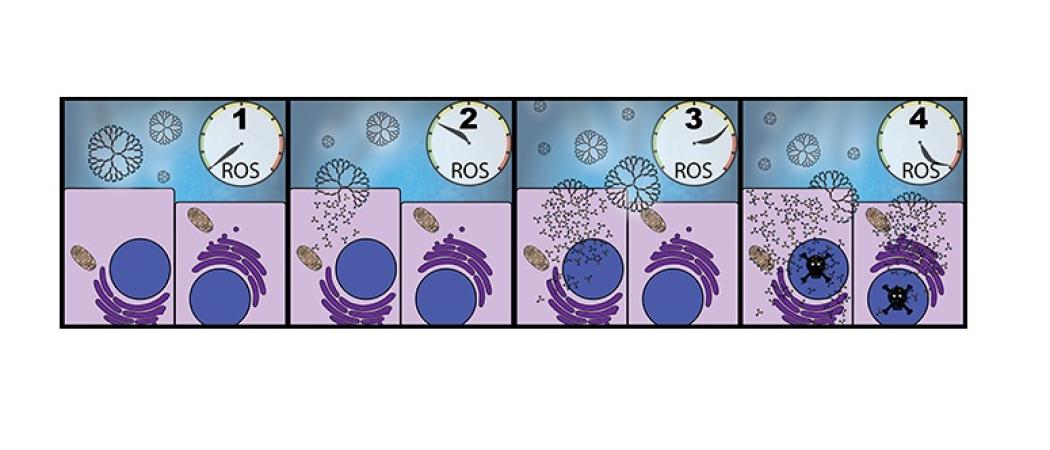
The four stages of the test: 1. Dendrimers, because of their size, can accumulate more in cancer tumors. 2. Cancer cells adsorb the dendrimers and begin breaking them down with the help of specific proteins, thereby generating ROS. More dendrimers accumulate, along with more ROS generation. 4. ROS reaches levels that finally lead to cell death.
Researchers from KTH have succeeded in taking the next step toward using man-made nanoscale compounds in the fight against cancer. A recent proof-of-concept study showed that dendrimers – which were first introduced in the 1980s – may be used to introduce compounds that essentially trick cancer cells into performing self-destructive tasks.
Dendrimers – or cascade molecules – are organically synthesized large molecules that match nature's peptides and proteins with respect to size and structure. Researchers from KTH Royal Institute of Technology took advantage of these qualities – and cancer cells’ appetite for adsorbing large molecules – by loading the material with an organic sulfur compound which is also a key ingredient in amino acids, peptides and proteins.
Applying these to cultured human cancer cells sets in motion a process that distracts cancer cells from their normal task of multiplying, and instead go to work on picking apart disulfide bonds in the dendrimers, says Michael Malkoch, a professor of fiber and polymer technology at KTH.
Malkoch says that this activity releases an increased concentration of reactive oxygen radicals (ROS), which eventually induces cell death. Unlike treatments like chemotherapy, the effect is selective toward cancer cells, leaving the healthy ones unaffected since healthy cells have a higher tolerance for ROS.
The nanomaterial is finally broken down by the body, he says.
The article was published in Journal of the American Chemical Society, and is co-authored by Malkoch, KTH doctoral student Oliver Andrén and Aristi P. Fernandes of Karolinska Institutet.
Their results show that the platform is worth continued research with clinical tests in which dendrimers are preprogrammed with large and specific numbers of organic disulfide bonds, Malkoch says.
"We’ve just scratched the surface for what you can do with dendrimers. We have previously tested using similar materials as a part of a leg patch – a type of adhesive that in some cases enables treatment of bone fractures without screws and plates,” he says. “You can imagine future applications where the material is used to coat implants around cancer tumors and thereby enable therapy treatment at a localized level.”
The research project is funded by the EU (Grant Agreement nr. 604182), the Wallenberg Academy Fellows program and the Swedish Research Council.
This release was first published on 13 December by KTH.





 A unique international forum for public research organisations and companies to connect their external engagement with strategic interests around their R&D system.
A unique international forum for public research organisations and companies to connect their external engagement with strategic interests around their R&D system.